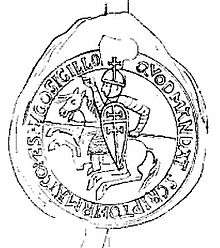Hugh, Count of Champagne

Hugh (c. 1074 – 1125) was the Count of Champagne from 1093 until his death.
Life
Hugh was the third son of Theobald III, Count of Blois and Adele of Valois, bearing the title Count of Bar-sur-Aube. His older brother Odo V, Count of Troyes, died in 1093,[1] leaving him master of Troyes, where he centred his court, and Vitry-le-François. In this way the three contiguous countships that formed the core of an emerging Champagne[1] were united in his person, and though he preferred "Count of Troyes", the oldest of his lordships and site of the only bishopric in his domains, his descendants chose to use only the title of Count of Champagne.
His first recorded act, a monastic gift in 1094, became the oldest document of the comital archive.[1] The act of his that resonated longest in history was his grant of lands in 1115 to the monk Bernard of the reformed Benedictines at Cîteaux—the Cistercians—in order to found Clairvaux Abbey, a Cistercian monastery at Clairvaux (in the present Ville-sous-la-Ferté), in a wild valley of a tributary of the Aube, where Bernard was appointed abbot and became famous as Bernard of Clairvaux. Hugh's charter makes over to the new foundation Clairvaux and its dependencies, fields, meadows, vineyards, woods and water. A deeply affectionate letter from Bernard to Hugh survives,[2] written in 1125, as Hugh went off for a third time to fight in the Holy Land, joining the Knights Templar, leaving his pregnant wife, and disinheriting his son Eudes I – Hugh believed himself impotent and never acknowledged his son. Instead, he transferred his titles to his nephew, who became Theobald II of Champagne. Eudes I two sons, Eudes II of Champlitte and William of Champlitte were important figures in the fourth crusade.[3]
Hugh married first Constance of France, daughter of King Philip I of France and Bertha of Holland. Their only child Manasses died young. He married second Isabella, daughter of Stephen I, Count of Burgundy, and had a son Eudes who was renounced along with his mother. Stephen's younger brother was Pope Callixtus II and his niece Beatrice married Holy Roman Emperor Frederick Barbarossa
When Hugh became a Knight Templar himself in 1125,[4] the Order comprised few more than a dozen knights, and the first Grand Master of the Templars was a vassal of his, Hugues de Payens, who had been with him at Jerusalem in 1114.[5]
Hugh was also the generous patron of the abbeys of Moustier-Ramey and of Molesme, at his castle of Isle-Aumont, south of Troyes. In a surviving letter to him from Yves of Chartres (Letter CCCXLV), the Bishop of Chartres reminds him of his obligations of marriage, perhaps to deter him from making vows of continence.
Notes
- 1 2 3 Theodore Evergates, The Aristocracy in the County of Champagne, 1100–1300, (University of Pennsylvania Press, 2007), 7.
- ↑ Bernard of Clairvaux, Letter XXXI: A Hugues, comte de Champagne, qui s'était fait Templier en l'an 1125 The editors' notes furnished biographical material for this article.
- ↑ George Finlay, A History of Greece: Mediaeval Greece and the empire of Trebizond, A.D. 1204 (Clarendon press, 1877) p. 175
- ↑ Jochen Schenk, Templar Families: Landowning Families and the order of the Temple in France, c. 1120-1307, (Cambridge University Press, 2012), 96.
- ↑ Karen Ralls, The Templars and the Grail: Knights of the Quest, (Quest Books, 2003), 46.
External links
- Hugues of Champagne (1093–1125) (French)
- The same (French)
| Preceded by Odo V |
Count of Champagne 1093–1125 |
Succeeded by Theobald II |